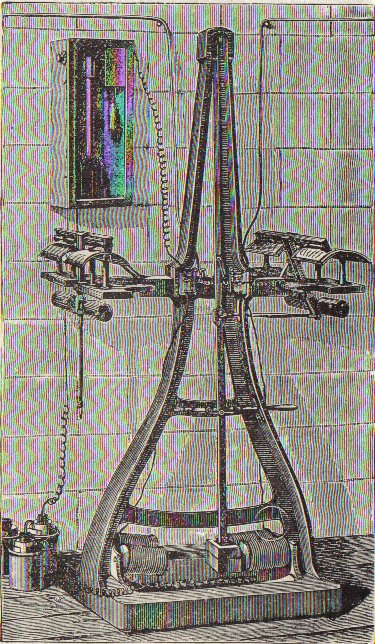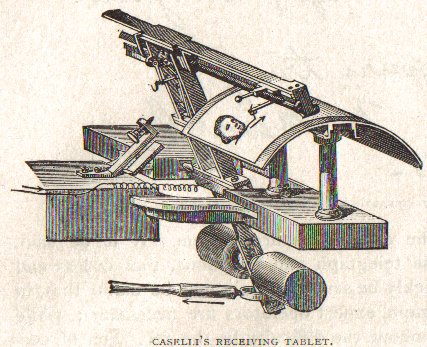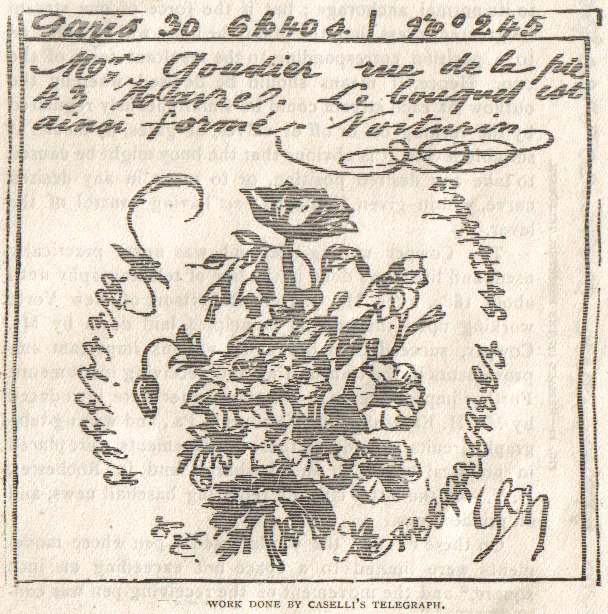One of the best known of the writing - or - copying - Telegraph systems is that invented in 1856 by Abbé Caselli, of Florence.
The apparatus employed at each station in this system is shown below.

It consisted of a pendulum six feet in length, with an iron bob weighting sixteen pounds, suspended from a iron frame. The pendulum was caused to oscilate between electromagnets, shown opposite the bob, by the alternate opening and closing of local battery, controlled by a “circuit breaker”, represented at the upper left corner of the figure.
At each side of the frame was placed a curved iron tablet. over which a pen attached to the main-line circuit was caused to pass.
One of these tablets served as a transmitter, the other as a receiver.

The pens received their motion from the pendulum by means of rods and levers, only one of the pens, however, being connected to the pendulum at once, The tablets were also, by suitiable mechanism, given a slow motion at right angles to the crosswise movement of the pens.
A message to be transmitted was written in ordinary ink on silvered paper which was placed upon the surface of the transmitting tablet. A sheet of chemically-prepared paper of similar size was placed upon the receiving tablet at the distant station.
The movement of the pendulum at each station then produced a corresponding movement of the transmitting and receiving pens over their respective tablets, and as a result current flowed or stopped in the circuit according as the transmitting pen passed over the inked or clear surface of the silvered paper.
The right angle motion of the tablets was so arranged tht the consecutive passages of the pens across the paper were separated by a very small space, as will be seen by examining the lines forming the characters in the specimen of the work done by this sytem, shown in the figure below.

This system was operated practically between Paris and Marseilles, a distance of 560 miles.
Modifications of this system have from time to time been introduced, for example, the Denison auto-telegraph, but apart from Caselli´s no copying-telegraph has been practically employed to any notable extent.
The Denison autotelegraph was virtually a miniature Caselli copying telegraph, the pendulum and tablets of the latter being replaced by small arms which were caused to traverse, at a high rate of speed, paper ribbons at the receiver and transmitter. The arms were operated by a “circuit--breaker”
Atographic electric systems or teleautographic systems, strictly speking- may be distinguished from fac-simile or copying telegraph systems by the fact that the former characters are electrical transmitted and reproduced at the receiving station at the very time they are being formed by the pen or pencil in the hands of the operator at the sending station.
It is plain that any device whereby this result can be accomplished, easily, quickly, and without intricate apparatus, will be of much utility in a variety of places.
For instance, by its means a merchant could send instructions from his office to his factory; brokerscould give quotions and execute orders without dispute, the correspondence being virtually, as the name of the system implies, in the handwriting of the contracting parties; sketches requiring despatch could be transmitted in the act of preparing them. If it be said, as regards the Morse telegraph and telephone, that orders and quotatations can as quickly be sent, the reply my be made that, in the case of the telegraph, expert operators are necessary; while in the case of the telephon the difficulty in the reception of certain articulate sounds, as well as the absence of a record, diminishes its usefulness in many transactions.
The first inventor in the line of teleautography, I believe was Mr. E. A. Cowper, of England, who termed his invention, made in 1874, a writing telegraph.
The Cowper writing telegraph was never practically used, and little was done in the line of teleautography until about 1884, when Mr. J. Hart Robertson, of New York, working upon the general principles laid down by Mr. Cowper, succeeded in producing various important improvements in the transmitting and receiveing instruments.
Further improvements in the transmitter were introduced by Mr. H. Etheridge, of Pittsburgh, PA, and writing telegraph circuits, embodying these emprovements, were placed in practical operation in Pittsburgh and in Rochester, N.Y., in the latter city for reporting baseball news, and on private lines.
In the teleautographic system just completed by Professor Elisha Gray, to whom the therm teleautograph is due, many imperfections and defects of previous writing telegraphs, including his own early inventions, have been avoided.
- (C) Marius Rensen


